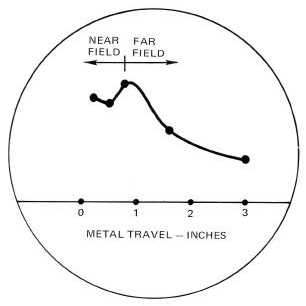T.O. 33B-1-1
5-47
b. Use all of the ASTM blocks with #5 FBHs that cover the range of metal travel distance to be used in the
inspection. For example, for inspecting a 2 inch specimen, use the inspection blocks with 1/8, 1/4, 1/2,
3/4, 1-1/2, and 3 inch metal travel; for inspecting a 1-1/2 inch specimen, use the blocks with 1/8, 1/4,
1/2, 3/4 and 1-1/2 inch metal travel; for inspecting a 5 inch specimen, use the 1/8, 1/4, 1/2, 3/4, 1- 1/2,
3, and 6 inch metal travel blocks.
c. From this group of blocks select the one with the longest metal travel distance. Place the search unit on
the part and adjust the time base using the delay and/or sweep controls until the peak of the initial pulse
is positioned on the 0 or first scale marker. Move the search unit until the maximum reflected signal
from the FBH is obtained. Position this reflected signal on another scale marker that will represent the
metal travel distance to the FBH without moving the initial pulse from the 0 marker. If, for example,
the largest block selected had a 3-inch metal travel distance, the signal from the FBH could be
positioned on the 6 or 9 scale marker to allow accurate measurement of the distance below the surface
for any indication. If the signal were positioned on the 9 scale marker, each scale marker would
represent 1/3 inch of metal travel distance.
d. Place the search unit on each block and adjust the position of the search unit to obtain a maximum
signal from the respective FBH. Note which block produced the largest FBH signal.
e. With the search unit on the block, which gives the maximum signal from the FBH, adjust the gain to
bring the signal amplitude to 80% of saturation.
f. Without changing the gain, sweep, or sweep delay, measure the maximum signal amplitudes from the
FBHs on the other test blocks. The height of each signal may be marked on the display face with a
grease pencil. Drawing a smooth curve through these points produces the DAC curve on the face of the
display. Figure 5-51 shows a typical DAC curve.
Figure 5-51. Typical Straight Beam DAC Curve.

